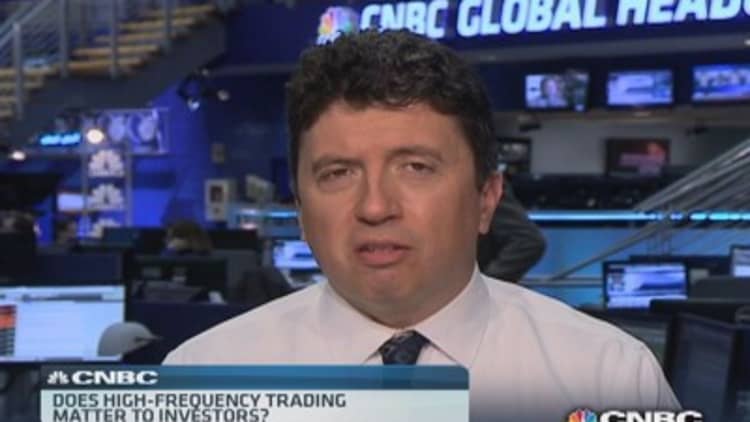High-speed trading platforms would begin to look less like tangled webs of impenetrable computer fortresses and more like old-fashioned exchange floors under a plan put forth by an academic consortium.
The proposal, advanced by the Stevens Institute of Technology and released publicly Thursday, would assign a specific role to certain high-frequency trading firms: Sort of a cyber-market-maker who would sit in the middle of the trading operation directing traffic but unable to do any actual trading.
That would separate the dual role of market maker and broker that has allowed sophisticated firms to get access to price movements ahead of slower competitors, creating an advantage that has caused some observers to say the market is unfair, according to the plan.
Michael Lewis released a book earlier this year called "Flash Boys" about the industry, and alleged in promotional interviews that the stock market is "rigged" because of advantages that high-speed traders enjoy.
In the Stevens proposal, advanced by the institute's financial engineering division, the solution would in some ways resemble one put forth in the Lewis book. Lewis profiled a firm called IEX, which devised a system called "Thor" that allowed for offers on stocks to reach the multiple exchanges simultaneously, preventing the front running that some HFT firms try to execute.

Read MoreSEC's plan to brakethe 'Flash Boys' draws critics
The Stevens plan would call for an "information transmission zoning," in which the various levels of market participants would be put into different zones, with market makers alone in the middle. HFT firms wanting to be market makers would have to register as such, and could not provide that service and trade simultaneously.
Jon Lukomnik, executive director of the nonprofit Investor Responsibility Research Center Institute, which commissioned the report, said the plan also helps mitigate the co-location benefits that some HFT traders enjoy. Firms have spent huge amounts of money trying to get physically closer to computer servers for exchanges in hopes of retrieving quotes more quickly—in fractions of a second against competitors.
"If you go back 40 years to the classic open-outcry pit ... if there was a technological advantage, there was a trader who wore a brighter-colored jacket," Lukomnik said. "That was it. In effect everyone had the same advantage. The guy at the center was a market maker. He wasn't allowed to front run. Now you have various types ... some are actually traders, some are in effect liquidity providers."
Read MoreCitadel CEO: HFT firms need to be secretive
The beauty of the Stevens proposal, its advocates say, is that it could be implemented with minimal market disruption.
A news release from the two groups explains the "information transmission zoning" plan:
Traders located within the innermost zone—defined as the zone wherein the trader receives prices prior to the general market—would be considered market makers and therefore be required to obey Securities and Exchange Commission market maker regulations. Traders outside this zone could act as traders. Drawing this distinction would create a fair playing field with respect to the dissemination of price information without decreasing liquidity. Additionally, adopting this approach would require minimal financial information flow re-architecting, would build on the SEC's National Market System (NMS), and would not require any major change in regulation or regulatory authority, according to the authors.
As has been the focus with the various fixes attempted at market structure in the age of trades based on algorithms that can be executed at incomprehensibly fast speeds, the study's authors say fairness is at issue.
"Some of the solutions in the system right now are ... focusing too much on managing interest from different angles," Khaldoun Khashanah, one of the study's lead authors, said in an interview. "Therefore, it's always going to be pulled one way or the other. The concept we would like to push forward is to manage principle. This is radically different."
Read MoreFidelity looking to open new trading platform
Lukomnik said the plan wouldn't require a complete overhaul of the system, just some clarity of what participants are allowed to do.
"Khaldoun and his research takes what exists now and superimposes a conceptual framework on it," he said. "What they are looking to do is starting from what exists, and the others start from what ought to exist."
To see the full white paper, go here.
—By CNBC's Jeff Cox






